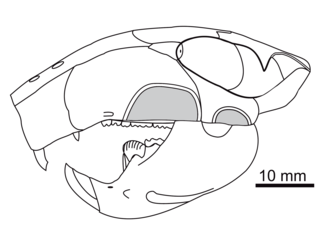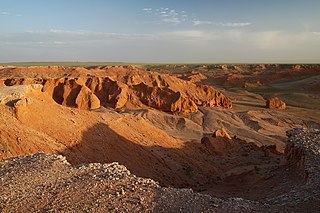Arginbaatar is a genus of extinct mammal from the Lower Cretaceous of Mongolia. It was a member of the Multituberculata, an order which is also extinct. It belongs to the family Arginbaataridae. The genus Arginbaatar was named by Trofimov B.A. in 1980. Baatar is Mongolian for "hero" or "warrior."

Plagiaulacida is a group of extinct multituberculate mammals. Multituberculates were among the most common mammals of the Mesozoic, "the age of the dinosaurs". Plagiaulacids are a paraphyletic grouping, containing all multituberculates that lie outside of the advanced group Cimolodonta. They ranged from the Middle Jurassic Period to the early Late Cretaceous of the northern hemisphere. During the Cenomanian, they were replaced by the more advanced cimolodontans.
Morrisonodon brentbaatar is an extinct multituberculate mammal from the Upper Jurassic Morrison Formation of North America.
Eobaatar is a genus of extinct mammal from the Lower Cretaceous of Mongolia, Spain and England. A member of the also extinct order Multituberculata, it lies within the suborder Plagiaulacida and family Eobaataridae. The genus Eobaatar was named by Kielan-Jaworowska Z., Dashzeveg D. and Trofimov B.A. in 1987. Its name was made from Greek "eos" = "dawn" and Mongolian "baatar" = "hero"", "warrior".
Monobaatar is a genus of extinct mammal from the Lower Cretaceous of Mongolia. It was within the also extinct order Multituberculata, and lived during the "age of the dinosaurs". It is also within the suborder "Plagiaulacida" and has been tentatively referred to the family Eobaataridae, though it probably is not a member.

Djadochtatherium is a mammal genus that lived in Mongolia during the Upper Cretaceous. It coexisted with some of the late dinosaurs. This animal was a member of the extinct order of Multituberculata. It is within the suborder of Cimolodonta, and a member of the family Djadochtatheriidae. It was named by G. G. Simpson in 1925, the name meaning "Djadokhta beast".

Kryptobaatar, also known as Gobibaatar or Tugrigbaatar, is an extinct mammalian genus dating from the Upper Cretaceous Period and identified in Central Asia. This animal was a member of the extinct order of Multituberculata within the suborder Cimolodonta, and was a member of the family Djadochtatheriidae. It lived contemporaneously with some of the dinosaurs. Its skull had a length of perhaps 3 cm.

Tombaatar is a mammal genus that existed during the Mongolian Upper Cretaceous period. It co-existed with some of the late dinosaurs. This animal was a member of the extinct order Multituberculata, within the suborder Cimolodonta and family Djadochtatheriidae. The genus Tombaatar was named by Rougier G.W., Novacek M. and Dashzeveg D. in 1997.
Buginbaatar is an extinct genus of mammal from the Upper Cretaceous of Mongolia. It is a member of the extinct order Multituberculata, within the suborder Cimolodonta and family Cimolomyidae. It lived towards the end of the Mesozoic era.

Pucadelphys is an extinct genus of non-marsupial metatherian. The genus contains a single species, P. andinus. Fossils of Pucadelphys have been found in the Santa Lucía Formation in Tiupampa in Bolivia.

Alphadon is an extinct genus of small, primitive mammal that was a member of the metatherians, a group of mammals that includes modern-day marsupials. Its fossils were first discovered and named by George Gaylord Simpson in 1929.

The Djadochta Formation is a highly fossiliferous geological formation situated in Central Asia, Gobi Desert, dating from the Late Cretaceous period, about 75 million to 71 million years ago. The type locality is the Bayn Dzak locality, famously known as the Flaming Cliffs. Reptile and mammal remains are among the fossils recovered from the formation.

Gobiconodon is an extinct genus of carnivorous mammals belonging to the family Gobiconodontidae. Undisputed records of Gobiconodon are restricted to the Early Cretaceous of Asia and North America, but isolated teeth attributed to the genus have also been described from formations in England and Morocco dating as far back as the Middle Jurassic. Species of Gobiconodon varied considerably in size, with G. ostromi, one of the larger species, being around the size of a modern Virginia opossum. Like other gobiconodontids, it possessed several speciations towards carnivory, such as shearing molariform teeth, large canine-like incisors and powerful jaw and forelimb musculature, indicating that it probably fed on vertebrate prey. Unusually among predatory mammals and other eutriconodonts, the lower canines were vestigial, with the first lower incisor pair having become massive and canine-like. Like the larger Repenomamus there might be some evidence of scavenging.

Deltatheroida is an extinct group of basal metatherians that were distantly related to modern marsupials. The majority of known members of the group lived in the Cretaceous; one species, Gurbanodelta kara, is known from the late Paleocene (Gashatan) of China. Their fossils are restricted to Central Asia and North America. This order can be defined as all metatherians closer to Deltatheridium than to Marsupialia.

Deltatheridiidae is an extinct family of basal carnivorous metatherians that lived during the Cretaceous and Paleogene. They were closely related to marsupials. Their fossils are restricted to Central Asia and North America. They mostly disappeared in the KT event, but a ghost lineage, currently represented by Gurbanodelta, survived until the late Paleocene by decreasing in size and becoming insectivorous.

Stagodontidae is an extinct family of carnivorous metatherian mammals that inhabited North America and Europe during the late Cretaceous, and possibly to the Eocene in South America.
Oxlestes is an extinct mammal from the Late Cretaceous of Asia, more specifically from the Cenomanian of Uzbekistan. A carnivorous species of uncertain affinities, it is notable for its relatively large size, being among the largest of all Mesozoic mammals. Due to the limited amount of material, it has been considered a nomen dubium.
Ukhaatherium is a now extinct species of mammal that lived during the upper Cretaceous about 84 to 72 million years ago in today's East Asia. It is known above all from the fossil locality Ukhaa Tolgod, Mongolia. An adult Ukhaatherium has an estimated weight of about 32g and bears several similarities to lipotyphlan insectivorans such as the tenrec.
Khuduklestes is a genus of extinct mammal of uncertain affinities from the Late Cretaceous of China. It is rather similar to the also carnivorous and taxonomically uncertain Oxlestes, being slightly smaller.

Tsagandelta is a genus of deltatheroidean therian mammal that lived in Asia during the Late Cretaceous. Distantly related to modern marsupials, it is part of Deltatheroida, a lineage of carnivorous metatherians common in the Cretaceous of Asia and among the most successful non-theropod carnivores of the region. It represents the first known mammal from the Bayan Shireh Formation.














